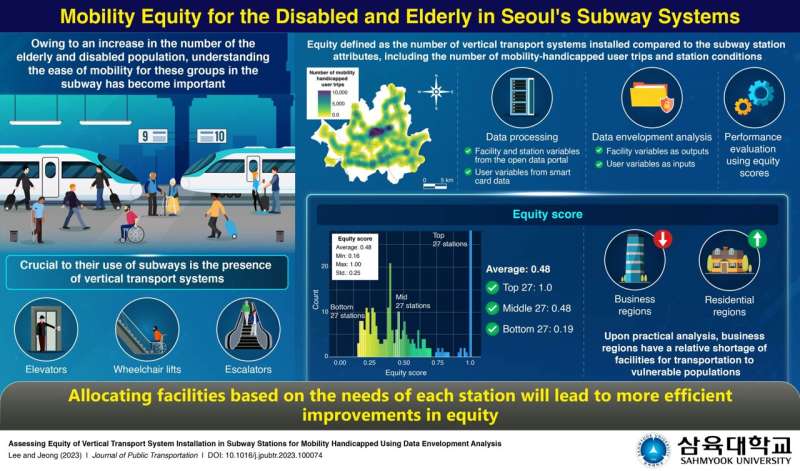This article has been reviewed according to Science X's editorial process and policies. Editors have highlighted the following attributes while ensuring the content's credibility:
fact-checked
proofread
Researcher proposes more equitable subway stations for the elderly and mobility handicapped

The number of elderly and mobility handicapped individuals has been increasing in South Korea. Statistics show that the number of elderly will increase over the next decade. Hence, the interest in equity for these people is becoming increasingly prominent.
The subway is one of the most efficient transportation modes for mobility handicapped individuals regarding cost, time, and accessibility, especially when getting around the city.
The government of South Korea has mandated a minimum number of vertical transport facilities for each subway station to ensure universal welfare. Many studies have tried to measure the equity of these vertical transport systems in their ability to assist mobility handicapped individuals.
Unfortunately, each subway station has different characteristics, in terms of its area, the number of mobility handicapped users, the available facilities, and so on. This could mean that some stations remain less accessible compared to others. In this regard, Professor Jonghwa Jeong from Sahmyook University, Korea, and Assistant Research Scientist Eun Hak Lee from the Texas A&M Transportation Institute in U.S. recently undertook a study to find the most equitable distribution of vertical transport facilities.
The study made available online in the Journal of Public Transportation on 28 October 2023.
Prof. Jeong says, "This work is important because according to the standards set by the government of South Korea, an elevator needs to be installed at only one of several entrances to a subway station."
"While this mandates the installation of basic facilities, the convenience of public transportation for individuals with mobility impairments could be significantly enhanced by considering the number of such users and the conditions of subway stations when investing in and allocating vertical transport systems."
The researchers defined equity as the number of vertical transport facilities compared to subway station attributes such as the number of mobility handicapped users and the size of the subway station. After that, they used the data envelopment analysis model to estimate the equity score of the subway stations.
Facility and station data were obtained from open data portal, and user variables were obtained from smart card data. The subway station was set as the decision-making unit, the number of elevators, wheelchair lifts, and escalators were set as the output, and the number of handicapped user trips, the number of floors in a station, and its area were set as the input variables in the model.
Since equity was defined as the number of vertical transport facilities compared to the station characteristics, the inputs (station characteristics) were maintained to get the appropriate number of outputs (vertical transport facilities). Furthermore, the researchers used Tobit regression to understand the impact of each input on estimated equity score.
The results of these studies showed that the average equity score for the subway stations in Seoul is 0.48. This means that much more investment is needed to ensure an equity score of 1.00. Of the 257 stations considered in the study, 27 stations had a score of 1.00. They were generally medium-sized stations with a lower number of trips.
The 27 stations that had a score of 0.48 were identified as smaller stations with a higher number of trips. In addition, 27 other stations with the lowest score of 0.19 were large stations with a medium number of trips. The Tobit regression showed that all the variables contributed significantly to the measure of equity.
The middle 27 stations required investments in elevators, while the bottom 27 stations required investments in escalators. The study also found that commercial and business districts of the city were the ones with the subway stations with lower scores, while residential areas had high-scoring subway stations. The researchers suggest that the strategy proposed in their study can be effective and efficient in enhancing the equity of vertical transport systems.
"With the equity score estimated from the proposed model, policymakers could invest in more equitable and efficient improvements in the public transportation system for the mobility handicapped by allocating transport facilities based on the needs of each station," points out Prof. Jeong.
More information: Eun Hak Lee et al, Assessing equity of vertical transport system installation in subway stations for mobility handicapped using data envelopment analysis, Journal of Public Transportation (2023). DOI: 10.1016/j.jpubtr.2023.100074
Provided by Sahmyook University




















